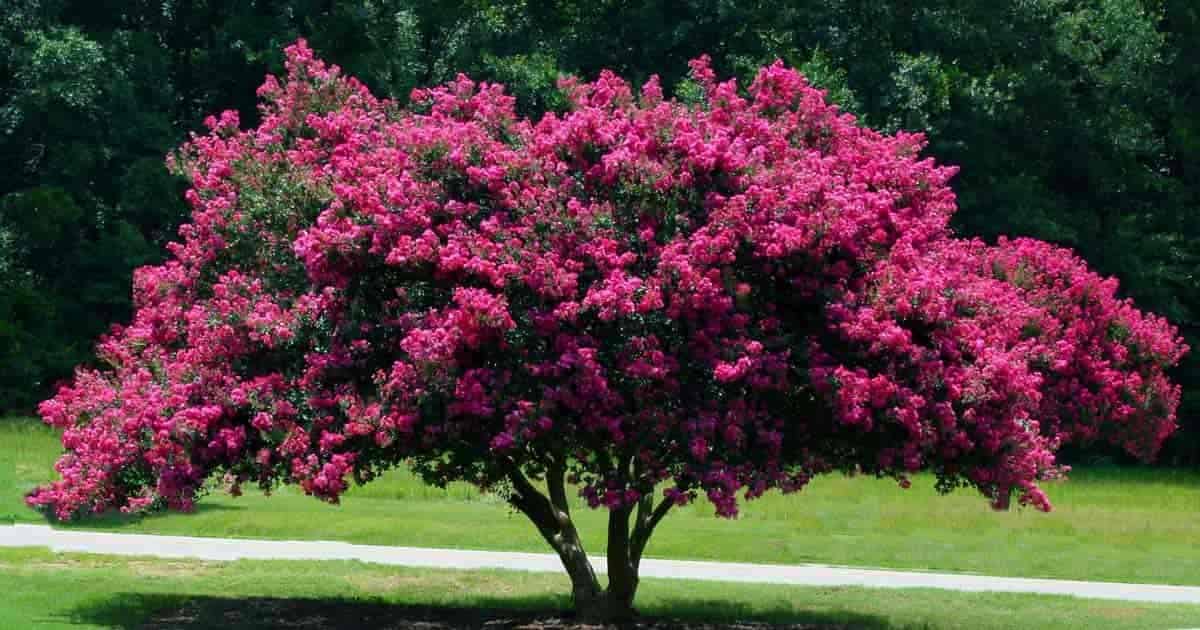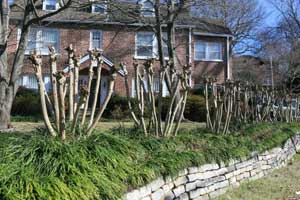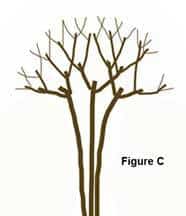Here’s the deal on Crepe Myrtle care. The Crepe Myrtle plant (Lagerstroemia indica) is a highly successful addition to any yard or garden landscape in the southern United States (USDA hardiness zone 6 to 9).
It is beautiful year-round with abundant showy blossoms and lush green leaves in the spring and summer.

On many Crepe Myrtle tree varieties, the leaves turn brilliant colors in the fall. These interesting trees and bushes also display attractive crepe myrtle bark in the wintertime.
In many areas of the South, Crepe Myrtles also called Crape Myrtles or Crapemyrtles have gone native or become naturalized.
In these places, Crepe Myrtles pretty well grow wild and the idea that you would need any instructions on how to care for crepe myrtle trees may even be considered laughable by gardeners who find themselves literally beating it back with a machete.
Nonetheless, if you do not have Crepe Myrtle trees or if you live in one of the areas where it doesn’t grow with quite such wild abandon you may find yourself needing a little bit of information on how to get it started and help it thrive.
In this article, we will share some smart information on giving your Crepe Myrtle tree the best start, caring for it and propagating it to share with friends. Read on to learn more.
Where Did Crepe Myrtle Trees Come From?
Some types of Crepe Myrtle trees are native to the southern United States, especially Florida. Some types come from Japan.

Crepe Myrtle varies in growing habits and range in size from as small as 3′ to 6′ feet tall to as tall as 30′ feet tall. Classifications include miniature, dwarf crepe myrtles, medium, and standard.
Most Crepe Myrtle trees you see in southern yards and gardens are of the following varieties:
Lagerstroemia Indica
The Lagerstroemia indica, a basic variety of the common Crepe Myrtle, comes in a number of different sizes, growing habits. Some are small shrubs, and some are medium-size trees. The taller types grow more erect, while the bushes tend to spread.
- Leaves: Generally speaking, leaves are very dark green and put on a lovely orange and red show in the autumn.
- Bark: During the growing season, the bark is light gray or brown. This peels off in the wintertime for a smooth, polished pinkish appearance.
- Blooms: Flower colors include pink, red and purple, and this variety puts on an especially impressive show of flowers during the summertime. Purple crepe myrtles will make a great addition to your garden.
Lagerstroemia indica is extremely heat and drought tolerant. Also, it can thrive in even very poor soil as long as drainage is good.
While some sub-varieties may suffer from cold in the upper south, if you choose Hopi, Centennial Spirit or Acoma you should have no problem in these areas.
In areas of high humidity, you may have problems with powdery mildew.
If you have this sort of environment, you are well advised to choose a cultivar of Lagerstroemia indica named for a Native American tribe, such as Hopi, Miami or Zuni.
All of these are resistant to mildew. If you do have a problem with mildew, you can spray with a mildew treatment such as Funginex.
Lagerstroemia Fauriei
Fauriei, also known as Japanese Crepe Myrtle, is especially hardy and mildew resistant. It grows very tall and erect (up to 30′ feet tall).
Fauriei sports small white flowers and light green leaves during the growing season. The leaves turn yellow in the autumn.
In the wintertime it presents an interesting show of grayish bark which flakes away to a deep, cinnamony brown color underneath.
Two well-known sub species of this variety are Kiowa and Fantasy, both of which are well-known for their very showy bark in the wintertime.
Lagerstroemia Speciosa
The Lagerstroemia speciosa, also known as Queen’s Crepe Myrtle, comes from the tropical south in the United States, where it thrives. It does not grow elsewhere.
Throughout the tropical south, Crepe Myrtle provides a lavish and abundant show year-round.
Trees are about 30′ feet tall and sport loads of blooms in purple, lavender, pink and white throughout the months of June and July.
Blossoms and leaves are all impressively large with individual blossoms being as big as 3″ inches across and foot-long leaves.
Following their abundant summer show, leaves turn a bright and impressive red in the autumn.
Queen Crepe Myrtle is such an enthusiastic grower that is very important to prune it back dramatically in the wintertime to keep its size under control.

Crepe Myrtle Care: Pruning!
Because Crepe Myrtle trees are so often overwhelming in its growth habits, many people take a very aggressive stance when pruning. Don’t succumb to this desire by chopping your Crepe Myrtle down to ground level in the late fall.
If you do this, you will end up with spindly and unattractive new growth from ugly stumps in the springtime. Use common sense and simply trim off the top 2′ or 3′ feet of your branches just before spring. Do this carefully with loppers or pruners rather than using an electric hedge trimmer.
Be sure to cut even with side branches of Crepe Myrtle so you do not have ugly, stubby stumps sticking out. Cutting smoothly along the stem, crotch or trunk presents a prettier silhouette and helps protect your tree from incursion by disease.
How to prune small crepe myrtle?
Pruned wrong… the shrub can get ugly. Steve Bender AKA “The Grumpy Gardener” even has a contest for the bad pruning has been called “crepe murder” by a local wholesale grower.
They often refer to it as… the prunage ritual!

Homeowners pull their pruning shears out of hibernation and make their annual pilgrimage to their front and backyards for the crepe myrtle prune-off! It’s a job that must be done for these colorful trees to show their stuff.
To help pruning Crepe Myrtle trees correctly, Steve has put together a step by step pruning guide you can check out at this link about Crepe Myrtle Pruning Step-by-Step –The Daily South

It always good to get input from several experts, so to add to Steve’s tutorial, Brent Wilson of Gardenality has a nice tutorial as well.
Brent talks about not allowing “peer pressure” from the neighbors to start pruning too early. Brent says, “the best time to trim crepes in is late winter or early spring – just prior to new growth emerging.”
He also has some nice graphics for pruning best practices. Read Brent’s tutorial on – Pruning Instructions For Crepe Myrtle Trees – From Gardenality
Many designers recommend planting in odd numbers like 1,3,5 and so on. Why not give you the same with Crepe Myrtle pruning – 3 tutorials!
The folks over at Fine Gardening agree with Steve and Brent… few people prune crepe myrtles correctly. Pruning correctly produces trees that are shaped gracefully and have more blooms standing upright on strong stems.
Do You Have To Live In The South To Grow Crepe Myrtle?
Generally speaking, these trees and bushes do better in the very warm and humid tropical South; however, clearly there are varieties of Lagerstroemia crepe myrtle trees do well in the cooler northern areas.
When choosing your saplings at the garden center, be sure to read the labels carefully. Make certain the type being offered is a type that will do well in your area.
You should also remember that your garden center is not the only place to get Crepe Myrtle. One way of being certain of getting a type that will do well in your area is to take cuttings or dig up saplings from existing thriving local trees and bushes. Be sure to ask your neighbors before you do this.
These outgoing flowering plants may also come right to you! If you live next door to someone who has Crepe Myrtle, be on the lookout for volunteers along your fence line. If a tree volunteers to live in your yard, you can be fairly certain it will do well! [source]
Planting Crepe Myrtle Saplings Successfully
When planting purchased Crepe Myrtle saplings, follow these steps to ensure success.
- Choose the right time. If you live in the tropical South, you can plant Crepe Myrtle any time of year. If you live in an area that freezes, you should plant early in the springtime.
- Keep it sunny! The more sun the better as far as Crepe Myrtle trees are concerned.
- Amend your soil correctly. Test the pH level of your soil. If it is between 6.0 and 7.3, you are fine. Your Crepe Myrtle will prefer soil that is a little bit acidic. To decrease the pH level, you should mix in some manure or compost or other organic matter. To increase the pH level, add some agricultural lime.
- Prepare your planting site. As with any sapling, your young tree will do best if you till the soil thoroughly before planting. All trees need well-drained, loose soil for good root growth. Add garden sand or peat moss to heavy clay soil.
- Provide plenty of root space. After tilling and amending the soil in the area where you wish to plant your tree, dig a generous hole. It should be quite wide but no deeper than the depth of the pot that holds your sapling. Be careful not to plant your sapling too deeply because the soil around the root ball should stay well-oxygenated.
- Surround your sapling with good soil. With your sapling in place, refill the hole with your well-tilled, properly amended soil. Tamp the soil to help hold your sapling in place, but don’t apply enough pressure to compact it. Again, you want to have good air circulation throughout the light, loose and nourishing soil surrounding your young tree.
- Add a blanket of mulch. After planting, it’s a good idea to add a nice thick layer of mulch to help hold moisture and nutrients in. Between 3″ and 5″ inches of wood mulch is a good idea. Be sure not to let it touch the trunk of your young tree because this can cause rot. It’s good idea to add a couple of inches of mulch every spring.
- Give your young tree a drink. Water your new sapling very thoroughly immediately after planting. Drench the leaves, trunk and branches and then allow a trickle of water to run at the base of your tree for an hour or so to make certain that the ground is thoroughly soaked. Keep a close eye on your sapling and give it a good drink anytime it shows signs of distress (e.g. wilting leaves). Otherwise, give it a good deep drink once a week.
[source]
Crepe Myrtle Tree Care
As mentioned, Crepe Myrtle trees often survive and thrive all on its own with little or no care whatsoever. Be that as it may for optimum performance, take heed of the following tips.
- Fertilize Crepe Myrtle trees annually in the springtime with a high nitrogen, slow-release crepe myrtle fertilizer.
- Prune judiciously late in the wintertime. For best results, remove shoots and buds growing at the base of the tree, along with branches that grow inwards rather than outwards. You should also remove new side branches that project from the bottom 4′ or 5′ feet of the tree.
- Continue pruning throughout the growing season by trimming off any spent flowers. This will encourage more blooms.

Observe your plants carefully to catch any diseases or problems as they emerge. Some common problems include black mold, powdery mildew and leaf spot, all of which can be treated by spraying with fungicide.
Powdery mildew, a disease caused by the fungus (Erysiphe lagerstroemia), stunts and distorts the leaves.
It appears as a white powdery fuzz on leaves, stems, and shoots of Crepe Myrtle. Although not fatal, powdery mildew often cause dwarfing and death of foliage.
Be advised that black mold is the result of aphid infestation.
If you notice aphids on your tree or bush, treat with insecticidal soap first. This should take care of the aphids and resolve your mold issue.
This should take care of the aphids and resolve your sooty mold problems. If it does not clear up the mold, follow up with fungicide.
Crepe Myrtle may also experience colonies of bark lice that do not harm the plant.
How To Propagate Crepe Myrtle
As mentioned, if you live in the South and have Crepe Myrtle shrubs living nearby, you may very well find them volunteering in your yard. If you don’t have the patience to wait, you can also propagate Crepe Myrtle very easily. When you see a specimen Crepe Myrtle that catches your eye, ask its owner if you can take a cutting or gather some seeds. [source]
Sow Seeds
To grow from seed, you would need to gather the seed. The process of flower turning to seed is somewhat lengthy and complex. Here are the stages you should watch for.
- The flowers transition into a pea-sized berry.
- Berry becomes a seed pod.
- Seed pod turns brown and splits open.
- The split seed pod looks like small flowers.
This final step takes place in the autumn. At this point, you can gather the seeds and save them to sow in the early spring. You can wait until all danger of frost has passed and press the seeds into the soil outdoors, or you can sow them indoors earlier to give them a head start.
To do this, simply fill small pots with a good quality of potting soil late in the springtime and press the seeds into the top of the soil. Sprinkle a bit of sphagnum moss over the seed and put the pot into a growing tray or a plastic grow bag. Keep it at about 75° degrees Fahrenheit in a well-lit location and watch for germination within a couple of weeks.
Grow Crepe Myrtle From Roots
Crepe Myrtle can also be grown from roots. To do this, you would simply dig up small volunteer trees or suckers early in the springtime and transfer them into pots.
Transplanted Crepe Myrtle saplings do need a little bit of special care. You should keep them in pots in a sheltered location with ample warmth and sunlight until they are well established as potted saplings.
Recommended Reading: Minimizing Tree Transplant Shock
At this time, you can transfer them to their permanent location (weather permitting). Follow instructions for planting a Crepe Myrtle sapling provided above.
Take A Crepe Myrtle Cutting
It is also very easy to propagate by Crepe Myrtle cuttings. Be sure to clip off your cutting at the point where the stem meets the main branch. It should be about six or 8 inches in length, and it should have three or four nodes (lumps along the stem where leaves emerge).
Be sure to take cuttings during the growing season (spring or summer). Once you’ve taken your Crepe Myrtle cutting, get it home as quickly as possible and remove all of the foliage except for the ones at the very tip of the cutting. Dip the cutting into rooting hormone to improve your chances of success.
Plant your Crepe Myrtle cutting in a pot of moist sand and potting mix to a depth of about 3″ to 4″ inches. Cover it with a plastic bag and keep it in a warm, well-lit place. It should root very well within a month.
Remember To Acclimate
When transitioning any of your new saplings to the outdoors, it’s a good idea to take your time and give them a chance to acclimate. Do this by setting the pots outdoors for a few hours a day once all danger of frost has passed.

When you see that your little Crepe Myrtle saplings seem to be growing and thriving with exposure to outdoor conditions, you will know that it is time to transplant them to their permanent locations. Be sure to provide lots of full sun, plenty of water and well-drained soil for best results.
